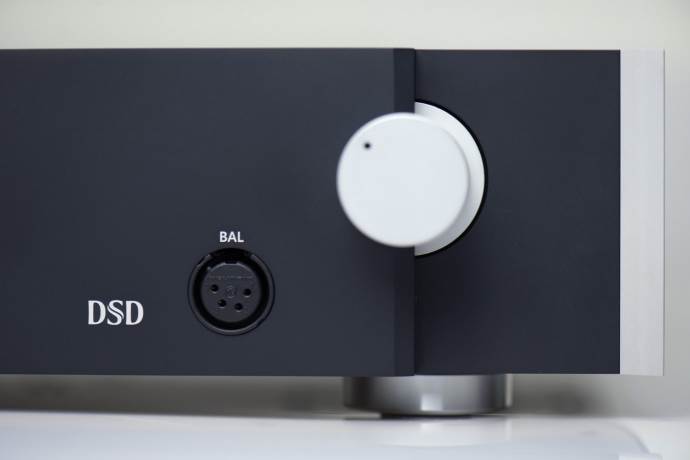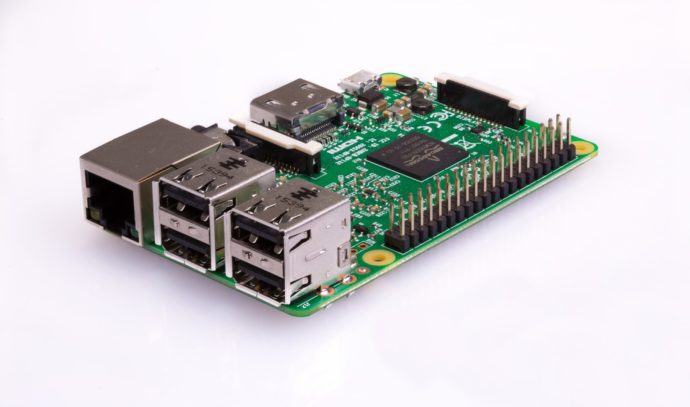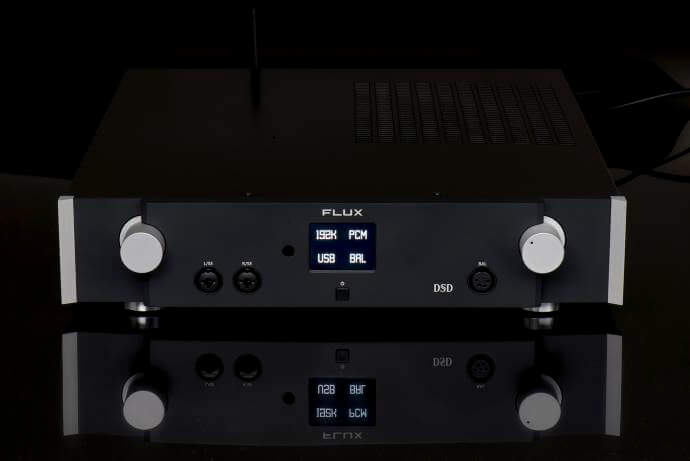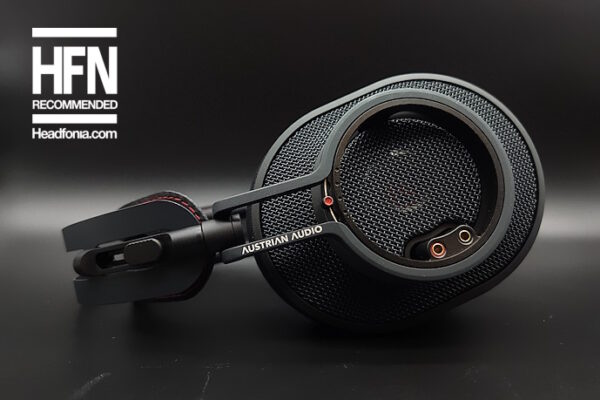It get’s more busy at the back and there you have more connectors than you’ve ever seen. From left to right:
- Single Ended or Balanced Pre Amp out (select via menu)
- Single Ended or Balanced DAC Out (Line Out)
- USB DAC input
- AES/EBU input
- BNC input
- Coaxial input
- Optical input I2S-LVDS input
- EXT USB connections
- The power chord socket
- The antenna for wireless network connection
- The network cable connector
- The update port
Everything looks nice and clean and it’s all easily accessible. Look-wise the Atlas also is quite nice, and the only thing I can (and will) complain about really is the size of the unit. I would have preferred it to be less deep with double the height in example, but I’m sure they had a good reason for not doing this.
Build Quality
The front panel is made of solid aluminium, milled on a high-precision five-axis milling machine (SMC Machine). Flux Acoustics uses top quality components on the inside and outside of the unit (see above, below + specs at he end of the article). An example are the high-quality connectors used to connect external devices to the Atlas. The RCA and XLR connectors are manufactured by CMC and AC-INLET Furutech and the XLR and headphone outputs on the front are made by Neutrik. Flux also uses an Oyaide single-crystal copper cable made in Japan for the internal analog wiring.
As you can see in the pictures Flux has beautifully designed and build the internals of this machine as well. Everything looks clean, well separated and isolated and it just breaths high end quality.
There are no complaints about the build quality at all.

Internals
The digital-analog part is built using two best-in-class converters made by Asahi Kasei Microdevices, the famous AK4497EQ. These converters have a lower level of non-linear distortion and have a noticeable superiority in dynamic range as compared to the previous generation. A dual mono circuit with one separate AK4497EQ chip per channel is used to ensure the maximum dynamic range and channel separation. 4 independent low-noise linear regulators are used for each chip including a separate core power supply taking into account the relatively high dependence of AK4497EQ on the power supply quality.
The signal of each AK4497EQ is filtered by an individual low-pass filter (LPF) developed entirely on a discrete-component circuit. The choice of such a complex decision is conditioned by the fact that only the use of certain radio parts which cannot be located inside single-chip devices (an operating amplifier) makes it possible to obtain a noticeably better result. The LPF circuit uses resistors made by the Japanese company Takman Electronics which are designed for the use in audio devices. Installing them in a discrete-component circuit of LPF allowed Flux to obtain an exceptional level of naturality and softness of the sound which is challenging or even impossible to achieve using the “factory-made” metal-film resistors and most surface-mounted resistors (SMD).
Those of you who have been reading Headfonia for a while will notice that the AK4497EQ is the exact same DAC chip that Astell&Kern is using in their SP1000 and SP1000M DAPs. Cayin also is using it in their flagship DAP, the award winning N8. The AK4497EQ is just a very good and very popular high end DAC chip.
Amanero Technologies software is used for integrated USB converter. It is arguably one of the best solutions for the output of a digital stream from USB in asynchronous mode. The USB connector is additionally isolated from the chassis of the device by means of an anti-short bushing. This minimizes the parasitic capacitive coupling between the USB connector that connects to the PC and the DAC case which is connected to the analog ground.
All digital signals at the output of the USB converter are galvanically isolated from the board on which the AK4497EQ digital-to-analog converters are installed on. This solution prevents the transmission of digital noise from the PC and prevents the formation of a parasitic circuit (an “earth” loop). As a result, it is possible to get the most clear sound of the system in any situation.
Clocking the digital part is carried out by the ultra-low-noise generators manufactured by Crystek Corporation – CCHD-575.
Full specs can be found here: https://fluxlab-acoustics.com/fluxlab-catalog/atlas/#undefined2

Streamer
So not only is the Atlas a pre-amp, headphone amplifier and DAC, it also is a (wireless) streamer that can stream your favorite music from a local Network Attached Storage (NAS). To do so the Atlas uses a Raspberry Network Core and it can link wireless or directly to a router for network music playback. The Flux Atlas can be also used without a computer to stream audio from any network device or USB-drive.
The easiest and only way to connect to the Atlas for streaming is by surfing to its dedicated IP, there is no application for your phone yet. It’s very easy though and the interface is simple and straightforward to use, but you do need some technical knowledge for installing and configuring the Atlas the first time round.
Once correctly connected you can start setting up the streamer and there are so many options to choose from. You probably won’t use 75% of them, but they’re there in case you need them. Inside the streamer there are 3 main screens: Internet radio, Music and Playback.
On the radio page you have a very large selection of online radio channels. On the music page you have the choice to stream from your NAS drives once configured, the online radio channels (again) and an SD CARD. Next to that there, as said, is a very detailed (and complicated) settings menu which will blow your mind. According to the settings menu you should be able to stream from Spotify and you can even run a scrobbler service. Renderers are BlueTooth, SqueezeLight, Spotify (premium users) and Airplay for the iOS users. There’s no TIDAL integration just yet and the unit isn’t ROON compliant at this time. As a result I am using the Atlas in combination with the S2 Ultra streamer from Pro-ject Audio, but I do hope to see it become ROON compliant one day.
It continues on the next page after the click here








Jason Bradshaw
11kg! Heavy gear! U could work out with this! I like it!
Stan
Thanks for extended review, Lieven!
Let me just add that based on one-month living with Atlas (accompanied by Meze Empyrean – both are outstanding!) I have to report that I2S/LVDS-through-HDMI input realized in Atlas on best way. It is rather rare thing. I have best performance using this type of connection with my transport.
Regards,
Stan
Pan
Seems like another company that makes excellent products but gets very little exposure. A few years back I heard the Head II from Trafomatic Audio and was blown away by their gorgeous sound. Before the audition I didn’t even know the company, and Googling it will tell you they still have relatively little exposure here in the state side. I ended up buying one this month. I know when its time to say goodbye the resale value is going to tank really hard, but given how good they sound, I’ll take the hit.
This Flux Lab company seems interesting. I’m really interested in the IRIY and IRIY TUBE, just that there’s no way to demo it….I’ll email the company owner and see what they can do.
Darek Kawulok
Thanks Lieven,
I wanted to ask you, after reading several of your reviews, if you had to chose and could use only one amp , what would it be ? Amp for both IEM and full cans I have 64audio u18t and am thinking of getting full size cans. And would like to have just one amp. What would you suggest ?
Thanks